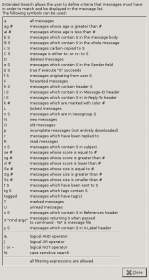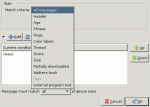I've been using claws-mail as my email client for a while.
Today I wanted to search all of my messages for some text and look through the results.
When I couldn't figure out how to do that even after consulting the claws manual, I went to their official IRC channel.
For reference, here are some screenshots of the dialogs in question:


This is what happened:
17:55 -!- .join mauke!~mauke@p3m/member/mauke #claws
17:55 -!- Irssi: #claws: Total of 33 nicks [8 ops, 0 halfops, 0 voices, 25 normal]
17:55 -!- Irssi: Join to #claws was synced in 1 secs
17:55 <mauke> hello, I am raging at claws-mail
18:08 <mauke> basically, the search feature is undocumented and I
can't figure out how it works
18:15 <mohaa> "undocumented" ?
18:16 <mauke> yeah, like: When in "Extended" mode, the "Information"
button is visible, enabling you to see the search
syntax.
18:17 <mauke> doesn't "enable" shit
18:17 <mauke> "Run on select" isn't even mentioned in the manual
18:17 <mauke> what is 'S' in the Information window?
18:18 <mauke> after I run a search, where are the results?
18:18 <mauke> what exactly does 'E' do and how is it useful?
18:19 <mauke> what is the unit of '#' in 'ag'?
18:19 <mauke> how is % supposed to be used?
18:19 <mauke> "all filtering expressions are allowed" - what are
"filtering expressions" and what does "allowed" mean
here?
18:20 <mauke> how is E different from X?
18:20 <mauke> are parens allowed? if not, how do expressions work?
18:21 <mauke> what's the unit of # in Se/Sg/Ss?
18:21 <mauke> why does the description of 'tg' ("messages which tags
contain S") randomly use "which" instead of "whose"?
18:22 <mauke> how does 'k' work?
18:22 <mauke> are the colors numbers?
18:24 <mohaa> "parens" ?
18:24 <mauke> yes
18:25 -!- .join krayon!~fallen@pdpc/supporter/28for7/krayon #claws
18:25 <mauke> I mean, how else does grouping work?
18:47 -!- .join andyrtr_laptop!~andyrtr@f053200240.adsl.alicedsl.de #claws
19:12 -!- .quit andyrtr!~andyrtr@archlinux/developer/andyrtr [Quit: Ex-Chat]
19:22 -!- .join Columbo0815!~foobar@HSI-KBW-085-216-116-089.hsi.kabelbw.de #claws
19:24 -!- .join claws_!~claws@5ad1377a.bb.sky.com #claws
19:24 -!- .mode clunker3 #claws [+o claws_]
19:25 -!- .nick claws_ -> claws
19:42 -!- .quit Columbo0815!~foobar@HSI-KBW-085-216-116-089.hsi.kabelbw.de [Quit: Verlassend]
19:43 <@claws> mauke: you're funny :)
19:44 <mauke> why?
19:45 <@claws> maybe you wouldn't rage so much if you'd never found
the feature or the feature didn't exist
19:45 <mauke> no, my main problem is the lack of a good search feature
19:45 <mauke> that's how this all started
19:45 <@claws> anyway, ignore the information dialog and click the
edit button - this is probably easier to digest
19:46 <mauke> no, the edit button seems to lack all features
19:46 <@claws> the quick search is a _very good_ search feature imo
19:46 <@claws> no, the edit button does not
19:46 <mauke> claws: yes, but I can't figure out how to use it
19:46 <mauke> see above
19:46 <@claws> have you worked out how to use Filtering in Claws?
19:46 <mauke> no
19:46 <@claws> heh, thought not
19:47 <mauke> btw, I blanked some spam pages in the wiki
19:47 <@claws> heh, yes. there are always new spam pages in the wiki
19:47 <@claws> thanks. saved me a job
19:48 <@claws> back to the quick search, what are you likely to want
to search for?
19:48 <mauke> text
19:48 <mauke> I want a full text search over everything
19:48 <@claws> b 'my search term' in Extended mode
19:48 <@claws> b is for body
19:48 <mauke> what happens if I omit the quotes?
19:49 <mauke> what happens with double quotes?
19:49 <mauke> how do I search for '?
19:49 <@claws> the quickest way to find your answer is to try it
19:50 <mauke> I did, results make no sense
19:50 <@claws> is that possible, perhaps?
19:50 <@claws> made no sense? in what way?
19:50 <mauke> why can't I just read a reference manual?
19:50 <@claws> dunno ...because you wouldn't??
19:50 <mauke> well, first there's problem #1: <mauke> after I run a
search, where are the results?
19:51 <@claws> because you haven't written it yet?
19:51 <@claws> the results are in the msg list - this list is
shortened, based on the results
19:51 <mauke> what msg list?
19:51 <@claws> that's quite obvious, i think, no???
19:51 <mauke> I have a nested folder structure
19:51 <@claws> now, m[e]s[sa]ge list _is_ in the manual!!
19:52 <@claws> the message list is not the folder list
19:52 <mauke> message list is the contents of one folder
19:52 <mauke> this is useless
19:52 <mauke> I don't want to manually click through all folders just
to see if one of them maybe contains some search results
19:53 <@claws> then search in the top-level folder and use a recursive
search
19:53 <mauke> I did
19:53 <@claws> that's not useless
19:53 <mauke> where are my results?
19:54 <@claws> a folder which has results has its folder icon replaced
with a magnifying glass. select that folder and you'll
see your results
19:54 <mauke> so I still have to manually click through the folders?
19:54 <mauke> blargh
19:54 <mauke> who came up with this UI
19:54 <@claws> why do you ask?
19:55 <mauke> that was more of a rhetorical question
19:55 <@claws> more like a rude question, methinks
19:55 <mauke> the search seems to ignore everything after the first
word
19:55 <@claws> then quote
19:55 <mauke> is that correct?
19:56 <@claws> doesn't a test answer your question?
19:56 <mauke> no
19:56 <mauke> I can't rule out that it has some effect I didn't notice
19:57 <mauke> hence "seems to ignore"
19:57 <@claws> is it me, but you seem to have an attitude??
19:58 <mauke> I do, but not where you think
19:58 <mauke> this confuses me a bit
19:59 <@claws> you do, but not where i think?? that confuses me
19:59 <mauke> I've been trying to be nice and civil at the end there
19:59 <@claws> maybe the beginning would have been better, but
whatever!
19:59 <@claws> the quick search is good, it works. maybe it doesn't
work how you want it to work, but there it is
20:00 <mauke> my main problem is not that it doesn't work how I want
it to, it's that it's not documented
20:00 <mauke> so I don't even know if it does what I want
20:01 <mauke> the list at the beginning is the "obvious" questions I
had when I saw the [Information] window
20:01 <mauke> the [Edit] dialog doesn't seem to allow a full text
search
20:02 <mauke> and I didn't notice the folder icon change at all
20:02 <mauke> what I find weird is that you can't give me a straight
answer as to what "b x y z" does
20:03 <mauke> normally I'd expect "RTFM" in response to that but there
doesn't seem to be a FM
20:03 <mauke> you said I should try it; I did. now I'm simply asking
for confirmation
20:04 <mauke> and all I get is "you seem to have an attitude"
20:08 <@claws> in the edit dialogue use phrase --> in body part
20:08 <mauke> oh wow
20:09 <@claws> maybe that's "all" you get because that's "all" you
gave?? :)
20:09 <mauke> I didn't even think to look there because Header, Age,
Flags, ... are other top-level categories
20:09 <@claws> in this case it's not RTFM, it's WTFM :)
20:10 <mauke> so I in analogy to Header I was looking for Body or
Message or whatever
20:10 <mauke> yeah, Phrase is the odd one out
20:10 <mauke> the other items specify which part/attribute of the
message to search *in*; Phrase describes what kind of
thing you're looking *for*
20:11 <mauke> claws: dude, I asked you a simple yes/no question
20:11 <mauke> you could answer 1) yes, 2) no, 3) rtfm at ...,
4) you're stupid because ...
20:12 <@claws> but none of those fitted my answer
20:12 <mauke> but this "I don't like your attitude" bullshit is
extremely annoying
20:12 <@claws> yep, i thought the same
20:12 <mauke> so why are you doing it?
20:13 <@claws> i'm not any more, i'm going to do something else
20:13 <mauke> sorry for assuming this program was meant to have users
Update 1:
- Changed the title from "shouldn't" to "don't want to" because that's closer to what I meant.
- Reformatted the log a bit to prevent the right side being cut off.
Update 2:
Oh wow, it keeps getting better.
I really wanted to know how this #!$@ actually works so I downloaded the source code.
It comes with a fairly long README that (among other things) explains Quick Search better than both the "user manual" and the built-in help system.
It even has examples!
First the filter engine syntax:
from regexpcase "foo"
subject regexp "Bug" & to regexp "claws-mail"
Then the extended patterns:
# means number
S means regexp string
f "john beavis" messages from john beavis
%f "John Beavis" messages from John Beavis (case sensitive)
~s foo messages which do not have foo in the subject
f foo & ~s bar messages from foo that do not have bar in thesubject
Still missing:
- What units are the # numbers in?
- What's the syntax for a "regexp string"?
- What regexp flavor?
But it does show that you can use double quotes and that the % should be placed immediately in front of one of the string operators.
(BTW, "S means regexp string" is the only occurrence of "regex" or "regul.*ex" in README, doc/, or manual/.)
...
Now I've looked at the source code.
Turns out claws-mail uses a rewriting system to convert "extended patterns" into "filter syntax" internally.
The actual syntax is a bit complicated:
- Tokens in the search expression are space separated.
- Every term in the expression starts with an (optionally prefixed) command.
- The prefixes are
!, ~ and %.
- You can have at most one of
! and ~ (both mean "not"). If you have one, it must appear first.
- You can also have
% (it means "case sensitive").
- If prefixes are present, they must appear in the above order with no whitespace in between (example:
!%f).
- Then comes the command code.
- Then the argument (if the command takes one).
- If the argument starts with a
" (double quote), it ends at the next ".
There is no way to embed a " in the string.
Otherwise it ends at the next ' ' (space, ASCII 32) character (not the next whitespace character!).
- As far as the rewriter is concerned,
& and | are just commands without arguments, not operators between commands.
That means there's no way to nest them (it also means ~& is accepted).
Regarding regex syntax:
- It uses
regcomp from regex.h with the REG_EXTENDED flag, so the flavor is POSIX Extended.
Regarding numeric units:
- Colors are something terrible (a message's "color value" is an integer whose parts are stored in different places; requires bitwise operations to reassemble).
I'm just going to assume that colors are numbered according to their appearance in the
Message > Color label submenu.
- Age is internally stored with a resolution of one second, but the search operators work in whole days.
- Size is the raw message size in bytes.
Conclusion:
If you're an end user, claws-mail may not be for you. Source diving seems to be the best way to get accurate and complete information on how the program works.


 I blog about Perl.
I blog about Perl.